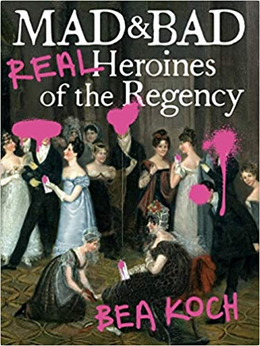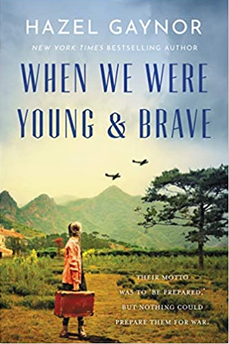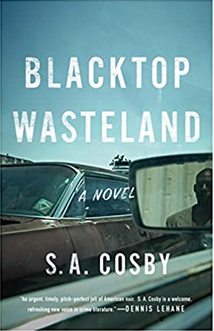Summer and Fall Reading Round-Up: History, Both Fiction and Non, Plus Hard-Boiled Crime
2020 has been a year for pulling the covers over my head and disappearing into books; that approach has been far preferable to facing reality. And I’m sending my very best to all the authors whose books have been released into this year of social distancing — as though launching a book into the world wasn’t hard enough already. Here are six that I’ve read in the last six months.

Mad and Bad: Real Heroines of the Regency
Bea Koch
Grand Central Publishing
“Regency romance” is a distinct and very popular genre of fiction — ignited by that most famous of Regency-period authors, Jane Austin — and one that author Bea Koch, owner of The Ripped Bodice indie bookstore in Culver City, California, knows well. Named for the ten-year period from 1810-1820 in which the Prince of Wales served as Regent for his ailing father, George III, the Regency left an outsized historical mark given its relatively tiny slice of time in between the Georgian and Victorian eras of English history. Koch’s objective in Mad and Bad is to highlight the women — famous (or infamous) in their time, talented, artistic, often trailblazing and unconventional — whose place in history has been diminished or largely ignored.
Koch focuses each chapter on a particular cohort of women, from the social arbiters to the royalty to the mistresses, to the artistic and the scientific. Some women are so ubiquitous that they make an appearance in virtually every chapter, such as Georgiana, Duchess of Devonshire, who checks several boxes herself and was a friend or patron to many of the women profiled here. It is this network of women supporting each other that is significant to the historical record the author illuminates for us. Helpfully, Koch ends each chapter with a “Recommended Reading” list that includes both fiction and non-fiction resources, along with occasional film recommendations. Koch provides an engaging and deeply researched homage to an era of exceptional women.
(As a bonus: readers who enjoy Mad and Bad may want to pair it with another 2020 Grand Central release, Rachel Vorona Cote’s Too Much: How Victorian Constraints Still Bind Women Today, which I reviewed for the Washington Independent Review of Books.)
***
Two historical novels I read recently are from widely disparate slices of history — one from the early 1600s and the other set during World War II — but share themes of deprivation, separation, and life in a brutally hostile environment.
The Brief and True Report of Temperance Flowerdew
Denise Heinze
Blackstone Publishing
When We Were Young and Brave
Hazel Gaynor
William Morrow Paperbacks

In Denise Heinze’s The Brief and True Report of Temperance Flowerdew, the first-person narrator, from many years’ remove, is hurrying to capture her witness to the near-collapse of the Jamestown settlement during the winter of 1609-10, which became known as The Starving Time. Like most of her fellow colonists, Temperance has none of the skills needed to survive in a harsh environment, though her maid Lily, with far more practical abilities, provides for them both. The modern reader may tend toward sympathy for the Native Americans who are forced to deal with the bumbling incompetence and increasing violence of the interlopers; fed up, they finally lay siege to the tiny settlement throughout that winter in order to rid themselves of the colonists. What becomes surprising is not that so many people died but that any survived at all. Of course, their method of survival lies at the heart of the story.

In Hazel Gaynor’s When We Were Young and Brave, a private school for the children of British and American missionaries in China comes under Japanese control at the outbreak of war in the Pacific. The story is told from the dual perspectives of ten-year-old Nancy Plummer and her teacher Elspeth Kent, whose unsentimental shepherding of her charges belies the many doubts she has about herself and her ability to hold up under the increasing brutality of their situation. She uses the discipline and focus of Girl Guides (similar to Girl Scouts) to instill a sense of order and purpose through their trials. As for Nancy, though it is a long British tradition for children to be sent away from their parents for schooling, her interior struggles drive home the emotional cost of that separation, even under the best of circumstances.
Both Heinze and Gaynor have done meticulous research into the historical record that underpins their stories, and both pull the reader into the time and place they describe. Their challenge in building a compelling story arc is that, generally, starvation and captivity are both slow, wearying processes. In the case of Flowerdew, Heinze hints at an underlying story of Temperance’s unhappy, politically motivated marriage of convenience to the second governor of Jamestown, Francis West, after being widowed by the first governor, Sir George Yeardley. Unfortunately, the tug of that untold story threatens to overshadow the one that Heinze has chosen to tell. For Brave, I almost felt that a narrative non-fiction treatment might have given the reader a deeper appreciation for this slice of history. Still, both of these stories feature intriguing women who are forced to find reserves that they did not know they had to pull their communities through the bitterest of trials.
***
Blacktop Wasteland
S. A. Cosby
Flatiron Books
S. A. Cosby’s debut novel, Blacktop Wasteland, has had mounds of praise heaped upon it, with blurbs from Lee Childs and Stephen King; its most recent accolade is being included in the New York Times list of 100 Notable Books of 2020. So the author hardly needs me to add my voice to the chorus, but I will. Of all the books I have enjoyed this year, this is the one for which I will give my own personal starred review.

Beauregard “Bug” Montage is getting squeezed from all sides: doctor bills for his boys, college tuition for his estranged daughter, a garage that’s losing business to the big new repair shop in town and rent coming due, and a nursing home that’s threatening to evict his snake-mean mother unless he can cover her debts. Bug is trying to do everything right, but nothing seems to be breaking his way. He’s a good husband and father, a good businessman and mechanic, a good and loyal friend. Unfortunately, he’s also the best get-away driver anywhere on the East Coast, a talent he inherited from his long-gone father. Thus, when some old associates insist they have the makings of the perfect heist, Bug weighs the risks and rewards and decides he has little choice but to join the crew.
Cosby does a remarkable job of turning the screws on his plot, where just as readers feel they are cresting the hill, another twist gets thrown in, the stakes keep growing, and the bad guys keep getting worse. Generally, I’m not a fan of the damaged anti-hero as protagonist, but in Beauregard Montage, Cosby has given us a fully realized character that we are genuinely pulling for, whose struggle toward redemption for himself and his family we can cheer.
As an aside, I listened to the audio book over the summer, as read by Adam Lazarre-White. Certainly listening to a book is a wholly different experience than reading it, but the narrator brought Cosby’s characters into living, breathing three-dimensional reality. This is a great one to listen to.
***

The Vultures
Mark Hannon
Apprentice House Press
Some stories are so steeped in the geography and culture of their locale that the place is practically one of the characters. Retired firefighter and author Mark Hannon is a native of Buffalo, New York, and that’s where he has located his protagonist, Pat Brogan, in both his first novel, Every Man for Himself, and now in his second, The Vultures, set in the early 1970s. In this latest, Brogan has just retired from the Buffalo police force and is now working as an investigator for the D.A. When the owner of the Buffalo Bills threatens to move the team unless he gets a new stadium, political and financial shenanigans abound in the initially well-intentioned quest to revitalize the ailing downtown while keeping the beloved team. As Brogan works to sort out which vulture is up to what, his elder son Rory suffers a catastrophic injury in Vietnam while his younger son Tommy is getting mixed up with radical war protestors on the UB campus.
Hannon does a fine job of laying out the many threads of his story, and pulls the reader along as she wonders how he is going to tie them all together. He has a knack for capturing his characters in a few quick, pointed strokes, though the constantly expanding cast is sometimes difficult to follow. But it’s clear that the author has a soft spot for many of his characters, as well as genuine affection for the scuffed-up city they inhabit.
***
They’re Gone
E. A. Barres
Crooked Lane Books

Fans of his previous crime fiction know him as E. A. Aymar; They’re Gone is the author’s first release writing as E. A. Barres. This latest follows The Unrepentant as his second novel exploring the brutal, ugly world of sex trafficking. Here, two women are thrown together when their husbands are both killed on the same night in the same way: two bullets, one to the head and another to the heart. Deb, a suburban mom in Northern Virginia, feels that she and her daughter Kim have lost their center, until she begins to discover that her husband Grant had a secret life involving prostitutes. Cessy, a bartender in Baltimore, is less sad when she learns her abusive husband won’t be coming home, but her relief is short-lived when the men he’s in debt to look to her to pay up.
Though it takes time for Deb and Cessy to find each other, the action cranks up quickly, and the bodies of both the innocent and guilty start to pile up. Cessy’s hard life has better prepared her to deal with the thugs who come after them, while Deb is initially far less capable in a series of life-or-death situations. Barres takes the time to develop his characters, and sprinkles in his signature quirky methods of comic relief amidst the rising tension, such as sending in Cessy’s cheerfully unhinged brother, Chris, to help deal with the bad guys, or having the politically powerful and efficiently brutal ringmaster be a self-enlightenment enthusiast who is constantly spouting things like, “Destiny reflects where you’re going, but strength is how you get there.” There are times when the killers seem as ill-prepared as their would-be victims — especially since one of them has inconveniently fallen in love with Deb — but Barres keeps things taut as he drives the story to a satisfyingly slam-bang climax. Most of all, though, I appreciate that Barres acknowledges that getting away is not the same as emerging unscathed.
Jennifer Bort Yacovissi
Jenny Yacovissi grew up in Bethesda, Maryland, just a bit farther up the hill from Washington, D.C. Her debut novel Up the Hill to Home is a fictionalized account of her mother’s family in Washington from the Civil War to the Great Depression. In addition to writing historical and contemporary literary fiction, Jenny reviews regularly for the Washington Independent Review of Books and the Historical Novel Society. She belongs to the National Book Critic’s Circle and PEN/America. She also owns a small project management and engineering consulting firm, and enjoys gardening and being on the water. Jenny lives with her husband Jim in Crownsville, Maryland. To learn more about the families in Up the Hill to Home and see photos and artifacts from their lives, visit http://www.jbyacovissi.com/about-the-book.
- Web |
- More Posts(33)